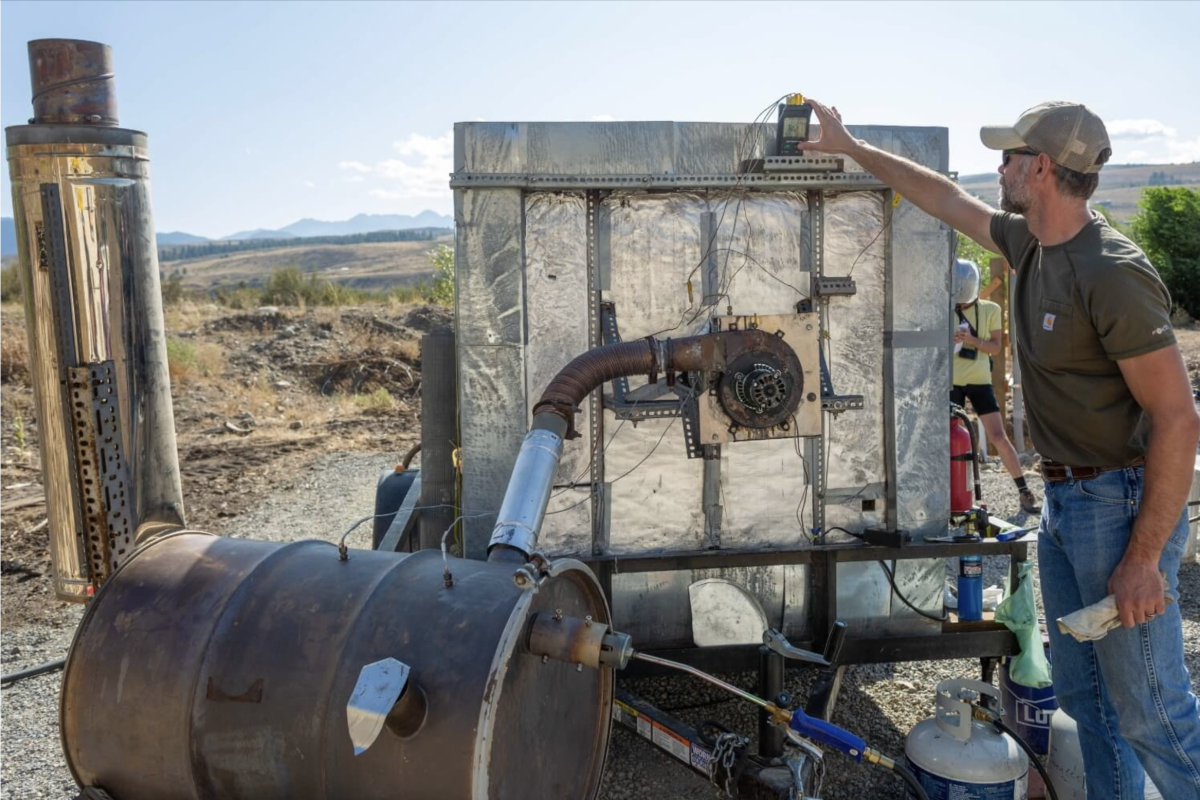STORY: Alum Mitigating Wildfire Risk with Biochar
February 19, 2023
Bret Richmond ’06 is creating a pilot system to turn wildfire fodder into sustainable products.
Bret Richmond ’06 is using his expertise in mechanical and systems engineering to help reduce wildfire risk in the Pacific Northwest by creating biochar in a sustainable way.
Because of decades of traditional fire suppression methodologies, many forests have become overly dense with small-diameter trees. Considered excess biomass, they contribute to wildfires due to their fuel loads and ability to carry fire into the upper portions of bigger, older trees. With drier conditions and higher temperatures due to climate change, wildfires now burn 8 million acres per year—an increase of 250 percent since the 1990s—and account for around eight percent of greenhouse gas emissions.

Bret Richmond'06 checks a gauge on the nonprofit’s new pyrolyzer near Winthrop, Washington. Photo: Tim Matsui/InvestigateWest
In his role as director of engineering at Washington-based nonprofit C6 Forest to Farm, Richmond is hoping to mitigate these issues by creating a pilot plant and process for turning this excess forest biomass into beneficial, nominally profitable products that also help the environment.
“C6 started about three years ago with the core mission of reducing wildfire risk in our region,” says Richmond. “We think that a key way to do that is by injecting some capital into the forest restoration system, and turning small-diameter trees into biochar is a great opportunity to create a valuable product at high volumes.”
To create biochar from the small-diameter trees, the logs are chipped, dried, and then heated to 400–600 degrees Celsius in a thermochemical reaction process called pyrolysis. The resulting lightweight, carbon-rich biochar can then be sold to farmers to boost soil health in their region and beyond.
The biochar itself comprises only about 25 percent of the output of the process; the remaining 75 percent is a vapor stream, some of which can be condensed into liquid and some of which is syngas, or synthetic gas.
“The condensed bioliquid can be valuable as a feedstock for biofuels or bioplastics,” says Richmond. “Application of these bioliquids is a relatively new field of research, but we’re trying to find an economical way to create revenue from this co-product by using off-the-shelf solutions instead of custom-made equipment.”
Richmond’s upbringing in the farmlands of Arkansas may have pointed him toward an engineering career from the start. Thanks to his father, a pipe welder, he knew how to weld by age 10 and was an avid tinkerer. Looking for an academic challenge, he began attending his state math and science school, where he took his first intro to engineering course.
At Olin, he spent plenty of time working hands-on and assisting in building out the infrastructure of the Shop. He interned for a few summers with then-startup BigBelly Solar, doing sheet metal drawings in his dorm room as he helped to develop their solar-powered, consumer-facing garbage compactor. Much of his career before C6 was spent at Synapse Product Development in Seattle, first as a mechanical engineer and eventually moving into engineering management and systems engineering roles.
“I have tons of gratitude for my experience at Olin; it set me up for the life I have now,” says Richmond.
Richmond lives in the Methow Valley in Washington with his family; his wife, fellow Olin alumnus Kate Richmond ’06 (née Cummings), is a principal engineer at Synapse, where she routinely provides strategic product development leadership for her teams and clients.